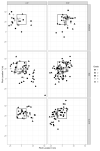Using Sensors for Player Development: Assessing Biomechanical Factors Related to Pitch Command and Velocity
- PMID: 36366188
- PMCID: PMC9655623
- DOI: 10.3390/s22218488
Using Sensors for Player Development: Assessing Biomechanical Factors Related to Pitch Command and Velocity
Abstract
Pitching biomechanical research is highly focused on injury prevention with little attention to how biomechanical data can facilitate skill development. The overall purpose of this study was to explore how sensor-derived segment kinematics and timing relate to command and ball velocity during baseball pitching. We used a cross-sectional design to analyze a series of pitches thrown from 10 collegiate baseball pitchers. We collected biomechanical data from six inertial sensors, subjective command from the pitchers, and ball velocity from a radar device. Stepwise regression analyses were used to explore biomechanical variables associated with command for all pitches and ball velocity for fastballs only. We found that only peak forearm linear acceleration was significantly associated with command, whereas several segment kinematic measures were significantly associated with ball velocity. Our results suggest that different biomechanical variables are linked to specific pithing skills. Our findings suggest that end-effector (forearm) movement is more important for pitch command, whereas proximal-to-distal (pelvis, trunk, upper arm, forearm) segmental movement is important for ball velocity.
Keywords: accelerometers; kinematics; pitching; skill; throwing; velocity; wearables.
Conflict of interest statement
The authors declare no conflict of interest.
Figures


Similar articles
-
Biomechanical Comparisons Among Fastball, Slider, Curveball, and Changeup Pitch Types and Between Balls and Strikes in Professional Baseball Pitchers.Am J Sports Med. 2017 Dec;45(14):3358-3367. doi: 10.1177/0363546517730052. Epub 2017 Oct 2. Am J Sports Med. 2017. PMID: 28968139
-
Biomechanical Analysis of Weighted-Ball Exercises for Baseball Pitchers.Sports Health. 2017 May/Jun;9(3):210-215. doi: 10.1177/1941738116679816. Epub 2016 Nov 1. Sports Health. 2017. PMID: 27872403 Free PMC article.
-
Association of Pitch Timing and Throwing Arm Kinetics in High School and Professional Pitchers.Am J Sports Med. 2021 Oct;49(12):3386-3394. doi: 10.1177/03635465211031853. Epub 2021 Aug 18. Am J Sports Med. 2021. PMID: 34406101
-
A Systematic Review of Lower-Body Kinematic and Strength Factors Associated With Pitch Velocity in Adult Baseball Pitchers.J Sport Rehabil. 2023 Feb 20;32(4):440-448. doi: 10.1123/jsr.2022-0059. Print 2023 May 1. J Sport Rehabil. 2023. PMID: 36809769
-
Kinematic Parameters Predictive of Pitch Velocity in Youth to Professional Baseball Pitchers: A Qualitative Systematic Review.Orthop J Sports Med. 2023 Nov 29;11(11):23259671231196539. doi: 10.1177/23259671231196539. eCollection 2023 Nov. Orthop J Sports Med. 2023. PMID: 38035212 Free PMC article. Review.
Cited by
-
Quantifying shoulder motion in the free-living environment using wearable inertial measurement units: Challenges and recommendations.J Biomech. 2025 Mar;182:112589. doi: 10.1016/j.jbiomech.2025.112589. Epub 2025 Feb 17. J Biomech. 2025. PMID: 39987887 Review.
References
-
- Zeppieri G., Jr., Bruner M.L., Michelini J.P., Farmer K.W. The Relationship Between Hip Range of Motion and Pitching Kinematics Related to Increased Elbow Valgus Loads in Collegiate Baseball Pitchers: A Pilot Study. Int. J. Sports Phys. Ther. 2021;16:468–476. doi: 10.26603/001c.21319. - DOI - PMC - PubMed
MeSH terms
Grants and funding
LinkOut - more resources
Full Text Sources

